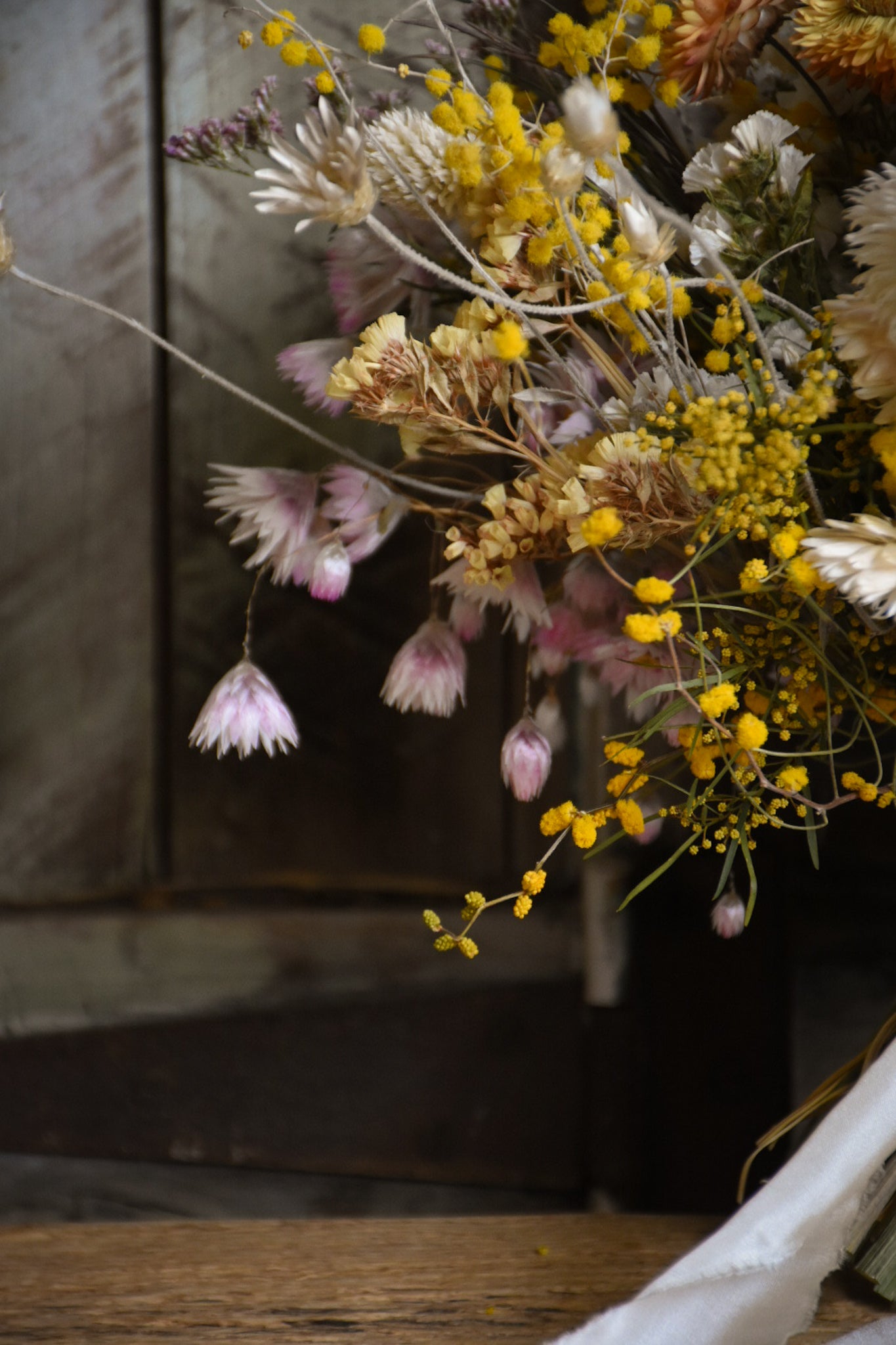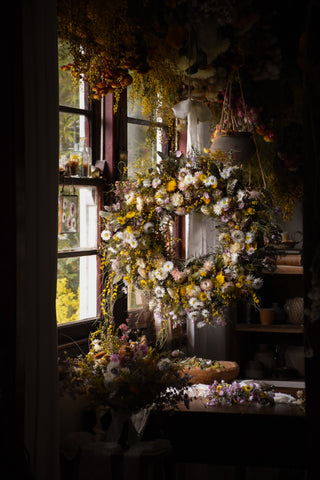Discover how to dry wattle flowers successfully at home...
INSPIRED BY THE SEASONS
In the middle of winter, something magical starts to happen in the wild Australian landscape... The days are chilly and crisp when the colour of the country melds with the sunshine and millions of little buds begin to appear in every corner of the bush... tiny spheres of sage that slowly transform into powdery puffs of gold, brightening the shorter days and singing the earliest songs of spring.
This, is wattle season, and acacias are the largest genus of flowering plants in Australia. Glowing with brightness and beauty, they appear throughout the bushlands and fill roadsides and gardens with colour; the cheerful, yellow flowers are so unique and are a celebrated addition to all floral creations.


This magical native is so clever... the flowers have evolved to cope with the harsh Australian climate by having no petals at all; each tiny bloom is a simple ball of pollen, usually dotted along a pendulous cluster, and the plant has no leaves, in their place are phyllodes, or flattened leaf stocks, which have evolved to conserve moisture and feel leathery like eucalyptus.
This has been my first year experimenting with wattle in my everlasting creations. I started to gather the flowers as soon as I noticed buds forming on the varieties that grow near my home. It was just pure luck that a gust of wreath orders came in around this time, spurring me use whatever wattle I could get a hold of, and then I went a bit wild with it... hanging bunches up to dry, tangling it into garlands, twisting it into bouquets... all in a bit of a hurry because as fast as it fills our world, I know it will disappear.


GATHERING
- This is a wonderful plant to forage as it is so abundant, just remember to tread lightly and take only what you need. You may even have one in your garden or a friendly neighbour who would be happy to share some of theirs with you.
- Start looking for wattle before it starts to bloom. I think that it is better to be too early than too late with this one. I find that the perfect stage is when the buds first start to turn yellow and plump up. If you cut and them at this point, they will hold the same look and shape. Once they are fully bloomed, it might be too late.
DRYING
- Use your wattle while it is still fresh; this way you can manipulate the flowers and they will not break or crumble. For some varieties you can pick off the green phyllodes, so you are left with just the flowers. When you are finished with your creation, hang it up somewhere dry and the flowers will set in place and dry completely.
- Cut and dry branches to use later. Strip off all of the leaves and flowers on the lower ¾ of the stems, bunch the stems together with a rubber band and hang them up to dry with a length of twine. You can then use these stems in bouquets and wreaths as the flowers will have dried nicely in an upward direction.
WHAT TO CREATE
- Cut off individual clusters while they are fresh and use some fine wire to make a gorgeous, golden flower garland. Wrap the wire a couple of times around the end of each cluster, move down the wire, and repeat. These look incredible hung by a window and would be fabulous to have around for the holidays.
- Press little clusters of flowers in a book or flower press, as they have such an interesting silhouette. Pressing flowers is essentially just another way of drying them, and so I think they look best when pressed in the early stages of blooming as well. I have a special little branch of wattle that I picked on the first day I went for a walk with my newborn baby Oliver. It is still in a flower frame on the wall and always reminds me of that special time.
- Cut off individual clusters and lay them out in a shallow basket to dry. Use them as floral confetti, for decorating tables, or for styling photo-shoots.
- Press little clusters of flowers in a book or flower press, as they have such an interesting silhouette. Pressing flowers is essentially just another way of drying them, and so I think they look best when pressed in the early stages of blooming as well. I have a special little branch of wattle that I picked on the first day I went for a walk with my newborn baby Oliver. It is still in a flower frame on the wall and always reminds me of that special time.
- Prepare short branches for making a wreath. Strip off the lower leaves and blooms and use while it is fresh. Hang your wreath up after you are finished and the wattle will finish drying in place, without crumbling.
- Use the longest stems you can find for bouquets. The wonderful texture of wattle looks so unique in a bouquet, and is a welcoming splash of colour in winter. You can use some pre-dried stems, or use it fresh and then hang your bouquet upside down until it dries completely.

Image: Details of the wattle garlands.

Image: Wreath orders that came in at just the right time, hanging in the potting shed.
VARIETIES FOR DRYING
Acacia podalyriifolia
The best variety for drying that I have found so far is the 'Queensland silver' wattle, also known as 'Mt. Morgan' wattle. It is perfect when it is just starting to flower and dried in place while it is in this stage. The little stems and flower clusters seem to hold together well, and it is also easy to pick off the phyllodes so you are left with just the flowers. I now have two of these growing in my garden, but please take care in doing this; an acacia planted outside of its natural habitat can become invasive. For me, this is an easy problem to avoid, because I am going to cut the flowers, preventing seed formation. Luckily, this is also a variety that doesn’t mind a good prune.
Acacia baileyana
'Cootamundra' wattle is widely available in the flower markets and has also worked well, but it is a bit more finicky and a bit more fragile. The flowers are not as big as the 'Queensland silver' wattle, and they can shrivel a bit when they dry, but they still work if you get them at the right time. The ferny blue-green phyllodes can also be plucked off before using.
Acacia macradenia
This is known as the 'zig-zag' wattle because the long, pendulous stems grow in a distinct zig-zag pattern. Growing to the size of a small tree, this wattle has huge panicles that are lush with flowers and have long, eucalyptus-like phyllodes. This one is really stunning, and it is just my luck that the neighbours down the road have one growing out the front of their house, spilling over the street. I drove by at just the right time one day when it had been cut back and I quickly filled up my car with the freshly cut blooms. The flowers are larger than the 'Queensland silver' wattle, they have dried perfectly, holding their shape and colour well. Again, timing is everything, just when the flower buds turn yellow. I hope to find more of this to use next year.
Acacia fimbriata
This is the 'fringed' wattle, the one that is growing over the fence in my neighbours’ yard and the same one that fills my local bushwalks and roadsides. The flower buds are tiny and glittery and the foliage is a deep green and is also really lovely dried; I prefer to use this one sparingly as a filler. It must be picked at the right time as well, before the flowers have fully bloomed, and it must be used fresh, otherwise it will crumble too much.
Acacia pendula
The is a very unique wattle, which I have growing out on the nature strip in front of my house. This is known as the ‘weeping myall’ and has incredibly long, weeping branches that dry wonderfully. They hold their shape and lovely colour and the phyllodes hold onto the stems well. The flowers are quite hidden on the shrub, and I don’t have much interest in them for drying, this one is all about the beautiful, blue-green foliage that has a touch of purple towards the tips of the branches.
Acacia merinthophora
This is another 'zig-zag' wattle, with the same distinctive stems that grow in a zig-zag pattern, but this variety have very fine phyllodes that are needle-like. It holds together very well when dried and you can easily pick some phyllodes off {I have been doing this after it is dried and in place in it's creation} to expose more of the flower without the buds falling off. I absolutely love it, especially with the unique way it trails. Use it to spill out of your bouquets or trail down from wreaths. Find bunches that are as fresh as possible, in a mid-flowering stage. As with all wattle, there may not be success with every single stem, so don't be discouraged by this, you are not alone!
Acacia terminalis
This is the ‘sunshine’ wattle, and is incredibly unique. I have not found {yet} another wattle that dries in this form. It has the familiar panicles of little flower buds, but each one of these flowers is highly geometric, like a cluster of tiny yellow orbs, and this shape is held when they are dried, from bud and even into their flowering stage. I recently hung up a bunch that I was certain was too far gone, but it turned out gorgeous. I hung it up high near the ceiling {with the winter heaters going} and against my studio window - and I wonder if that zap of heat was helpful with the process.
To be continued! I will add new varieties that I have trialed here each winter.

THANK YOU
Thank you so much for being here and I hope you have enjoyed celebrating the beauty of these magnificent flowers with me. Again, and I can't stress this enough - not every bunch of wattle you dry with turn out just right, there will always be some stems that might brown or break. But I do believe that the best rule for success is fresh, fresh fresh! I find the fresher the wattle is, the better it will dry. Much like all flowers.
And the best thing about wattle is that there there is certainly no shortage of it in Australia, and there will always be so much more to learn and experiment with; there are just so many varieties, {even a pink one!} and I am sure that more will become available in nurseries and flower markets in time. I have already visited my local native nursery to purchase plants and now have two seedlings rocketing away in my side yard. They grow so quickly that I may just have some of my own homegrown blooms to work with next winter.
With much love,
Elizabeth xx
- This was originally written in 2022 with updates in winter 2023.








Marlena Hirsch
Thanks for sharing. Acacia is blooming here in northern California. We will dry some more for our flower project of giving away small bouquets at the food-give-away program and a couple of small nursing homes. Acacia is a welcome flower now when few other plants are blooming.
Jasmine
Thank you so much for this info. I’ve preserved some wattle and I want to use it for Christmas wreaths. How long does your dried wattle keep its yellow colour?